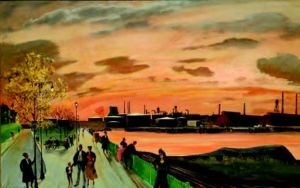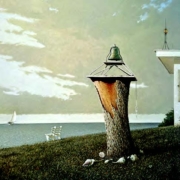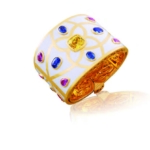Egg in Paint? ASK THE ARTSPERTS Kristine Meek and Juliana Meek

Juliana Meek and Kristine Meek
Dear Artsperts,
I saw an article that scientists recently analyzed Leonardo da Vinci’s paint and discovered it contained protein, likely from eggs. Can you tell me more about egg in paint?
Just Yolking
Dear Yolking,
Artists have used both egg and milk protein in paints for centuries. The surprise in this discovery is that Renaissance era artists were mixing egg with oil paint. We have long known about the process of creating egg tempera, where egg yolk is combined with pigments. This technique was first used by ancient Egyptians.
To better explain the process of creating egg tempera, the yolk is never used by itself with pigment because it dries almost immediately and cracks once dried. To prevent this, artists use an agent like vinegar, water, or white wine in variable proportions. As tempera dries, the artist will add more water to preserve the
consistency and to balance the thickening of the yolk on contact with air. Once prepared, the paint cannot be stored. Egg tempera is water-resistant, but not waterproof.
Egg tempera is not a flexible paint – it dries both hard and fast. Anyone whose house has been the victim of an egging will understand this. To use this paint, artists almost “dot” the paint onto the surface because normal paint strokes take too long with such fast drying paint. Tempera paintings are very long lasting, and examples from the early centuries still exist today. In fact, every surviving panel painting by Michelangelo is egg tempera. Previously it was believed that egg tempera painting was superseded by the invention and popularity of oil painting beginning in the 1500s.

“Sunday Sunset Staten Island” by Adolf Dehn (1895-1968), Casein on panel, 28” x 42”, 1956
Casein is paint created by mixing pigment with milk protein.
The discovery of protein in the oil paints of the Renaissance era sheds new light on these early oil paintings. Artists would have been long familiar with egg tempera. It may have been that they were more confident using egg yolk with pigments, instead of relying solely on the new technique of mixing oil and pigment. There may have been other advantages in that the artists preferred the look of egg tempera, but wanted the convenience of oil paint. Oil paint is much easier to work with and it will last longer without drying out. Artists of the Renaissance may have discovered that combining the process for creating egg tempera with creating oil paint was the best of both worlds.
We have not known any artist in recent times to combine egg yolk with oil paint. However, we have represented artists who work in egg tempera: Robert Vickrey (1926-2011) and William Entrekin. We also represent the estate of Adolf Dehn (1895-1968) who painted with casein, which is pigment combined with milk protein.
…And that’s no yolk!
Sincerely,
The Artsperts
Featured Photo: “Bayside” by William Entrekin, Egg Tempera on panel, 24” x 24”, 2019. Egg Tempera has been used since ancient Egypt, where pigment is mixed with egg yolk to create paint.

599 NINTH STREET, NORTH, SUITE 309 | NAPLES, FL 34102 | 239.261.2637




Leave a Reply
Want to join the discussion?Feel free to contribute!